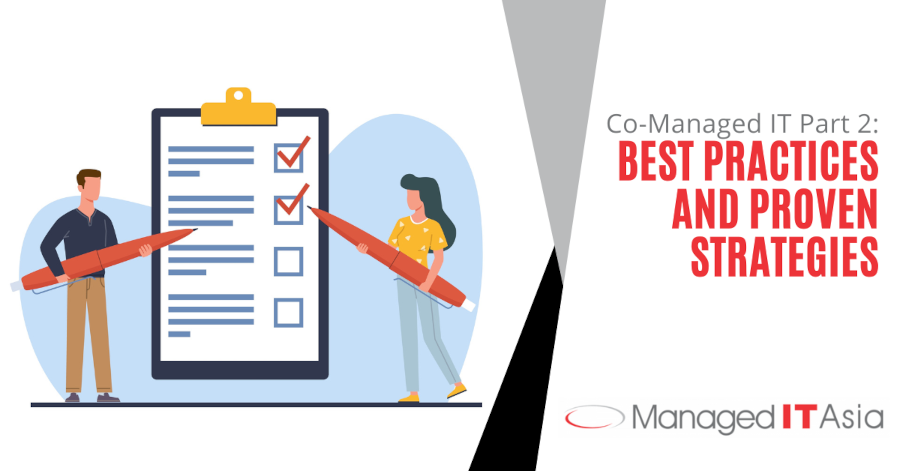In the rapidly evolving landscape of Information Technology (IT), businesses are continually seeking innovative solutions to enhance their operational efficiency and security. Co-Managed IT, an approach that combines in-house IT teams with externally managed service providers, has emerged as a compelling solution. Building on the foundations laid in Part 1, this article explores the best practices and proven strategies for successful implementation of Co-Managed IT services.
Understanding Co-Managed IT: A Recap
Before delving into best practices, let’s revisit the concept of Co-Managed IT. This approach involves collaboration between an organization’s internal IT team and an external managed service provider (MSP). While the internal team focuses on day-to-day operations, the MSP brings specialized expertise and resources, creating a symbiotic relationship that optimizes IT performance.
Key Benefits Recap:
- Scalability: Seamlessly scale IT resources based on evolving business needs.
- Cost-Efficiency: Optimise costs by accessing external expertise without the overhead of full outsourcing.
- Enhanced Security: Leverage specialized security measures provided by the MSP.
- Proactive Maintenance: Address potential issues before they impact operations.
Best Practices for Co-Managed IT Success
1. Establish Clear Communication Protocols
Effective communication is the linchpin of successful Co-Managed IT. Establish clear communication channels, ensuring that both internal and external teams are on the same page. Regular meetings, status updates, and collaborative tools contribute to a transparent and efficient workflow.
2. Define Roles and Responsibilities
Clearly defined roles and responsibilities are fundamental to avoid confusion and streamline operations. Outline the specific tasks and functions that each team will handle. This not only prevents overlap but also ensures accountability for specific areas of IT management.
3. Foster Collaboration and Knowledge Sharing
Promote a culture of collaboration between internal and external teams. Encourage knowledge-sharing sessions, where insights gained from each side can be disseminated. This collaborative approach enhances the overall expertise of the combined IT force.
4. Leverage Advanced Monitoring and Management Tools
Invest in cutting-edge monitoring and management tools that provide real-time insights into IT infrastructure. These tools empower both teams to proactively identify and resolve issues before they escalate, minimizing downtime and disruptions.
5. Prioritise Cybersecurity Measures
In today’s digital landscape, cybersecurity is paramount. Collaborate closely with your MSP to implement robust cybersecurity measures. Regular audits, employee training, and staying abreast of the latest threats are crucial components of a comprehensive cybersecurity strategy.
6. Implement a Comprehensive Disaster Recovery Plan
Unforeseen events can disrupt business operations. Work hand in hand with your Co-Managed IT provider to develop and implement a comprehensive disaster recovery plan. Regularly test the plan to ensure its effectiveness in minimizing downtime during critical situations.
7. Regularly Review and Update IT Policies
IT policies should evolve with the changing technological landscape. Regularly review and update policies to align with industry best practices and compliance standards. This ensures that your IT infrastructure remains resilient and compliant with relevant regulations.
Proven Strategies for Co-Managed IT Optimization
1. Assess and Align with Business Goals
Regularly assess the performance of your Co-Managed IT arrangement against the broader business goals. Ensure that the partnership aligns with the organization’s strategic objectives, making necessary adjustments as the business evolves.
2. Continuous Training and Skill Development
Invest in ongoing training and skill development for both internal and external teams. This ensures that all team members stay current with the latest technologies and industry trends, maximizing the potential of the Co-Managed IT model.
3. Conduct Regular Performance Reviews
Implement a system for regular performance reviews, analyzing key metrics and outcomes. This data-driven approach allows you to identify areas of improvement, optimize processes, and celebrate successes within the Co-Managed IT framework.
4. Stay Agile and Adaptable
The IT landscape is dynamic, with new challenges and opportunities emerging regularly. Foster an agile and adaptable mindset within the Co-Managed IT framework, allowing both teams to respond swiftly to changes in technology, security threats, and business requirements.
Elevate Your IT Strategy with Co-Managed IT
Co-Managed IT is a powerful approach that, when executed with precision, can elevate your organization’s IT strategy to new heights. By implementing the best practices and proven strategies outlined in this article, businesses can unlock the full potential of their IT infrastructure. In a world where technology is the heartbeat of modern enterprises, embracing Co-Managed IT with the right partner is a strategic decision that pays dividends in efficiency, security, and scalability. If you’re ready to take your IT strategy to the next level, contact Managed IT – We Manage Small Business IT today. Our team is dedicated to helping businesses thrive in the digital era, providing tailored solutions that align with your unique needs and objectives.
MANAGED IT ASIA, we are an IT Support, IT Solutioning and Managed IT Service Provider specializing in serving Small Businesses across Asia. Call us at +65 6748 8776 and let us manage your Small Business IT today!
